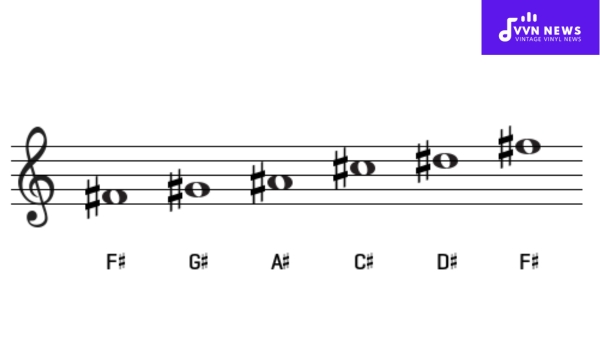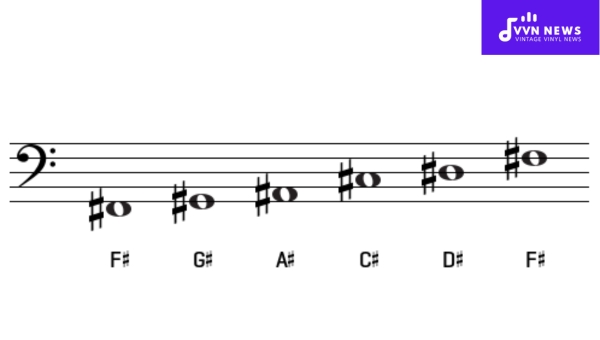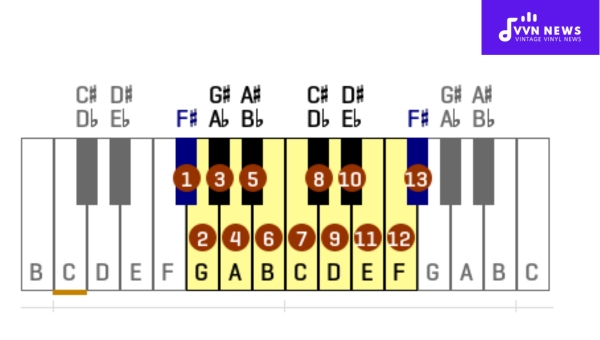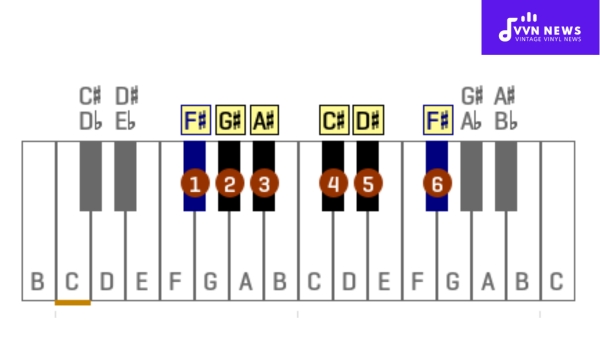When I first stumbled upon the F sharp major pentatonic scale, I was fascinated by its unique sound and versatility.
It’s a scale that breathes life into my music, something that makes my compositions stand out.
Despite its seemingly complex name, this scale can be quickly mastered with a little bit of practice and patience.
The beauty of the F sharp major pentatonic scale lies in its simplicity.
Unlike some other scales that have seven or eight tones, the pentatonic scale only possesses five distinctive tones which make it easy to memorize as well as play.
If music is your passion, this basic building block will undoubtedly enhance your musical prowess.
What is the F Sharp Major Pentatonic Scale?
The F Sharp Major Pentatonic Scale is a musical scale with five pitches per octave – F#, G#, A#, C#, and E#.
Each note within this scale holds a significant contribution to create an unmistakable sound, that’s familiar yet refreshing.
It is widely used in various types of music, like Blues, Rock, Pop, and Jazz, to name a few. Its base, or root note, is F sharp (F#).
This denotes that every time your piece of composition begins or concludes on the F# major note, it adds a sense of resolution that appeals to the listener’s ear.
How is the F Sharp Major Pentatonic Scale Structured?
The F sharp major pentatonic scale is formed by harmoniously assembling a sequence of five notes from the standard major scale.

This pentatonic variant specifically excludes the fourth and seventh scale degrees, which are often the source of tension in a heptatonic (seven-note) scale.
By doing so, it emphasizes a more consonant and uplifting tonal atmosphere.
In terms of its construction, let’s dissect this particular scale:
- Begin with the root note: F♯.
- Move to the second degree: G♯.
- Ascend to the third degree: A♯.
- Overstep the normally dissonant fourth by proceeding directly to the fifth: C♯.
- Conclude with the sixth degree: D♯, leaving out the sensitive seventh note.
This configuration—F♯, G♯, A♯, C♯, D♯—creates an easy-to-remember pattern that shines in various musical genres for its pleasant and resolved sound palette.
Both guitarists and pianists find this structure approachable for creative improvisations or crafting melodic lines within their compositions.
Also Read: E Flat Major Pentatonic Scale [Play Warm And Harmonic Tunes]
What are the F Sharp Major Pentatonic Scale’s five designs?
The F sharp major pentatonic scale is a melodic treasure trove for guitarists and instrumentalists alike.
Its five distinct shapes on the fretboard form the backbone for countless melodies and solos across various musical genres.
Each shape offers a unique pathway through these melodic landscapes, allowing players to navigate with eloquence and flair.
Shape One: The Root Position
The first shape begins at the root note, F#. Positioned typically around the second fret of the low E string, it extends to include notes on adjacent strings, covering a four-fret span.
This shape is your foundational starting point, often regarded as a Home Base for launching into scalable explorations.
Shape Two: The Extended Reach
Transitioning from shape one, to shape two expands your reach up the fretboard, often starting around the fourth fret.
This design supports seamless transitions to higher octaves while maintaining the scale’s integrity.
Picture this as an extended arm that reaches further into the melodic space above the root position.
Shape Three: The Upper Octave Springboard
Arguably one of the most dynamic designs in this pentatonic playground is shape three.
Starting around the seventh fret, which encompasses F# in its higher octave, it serves as a springboard for soaring solos and vibrant expressions at elevated pitch levels.
Shape Four: The Midway Convergence
Shape Four’s magic lies around the ninth fret. What makes this variant exceptional is its ability to blend notes in an area where several shapes converge.
It’s akin to a crossroad that connects various pathways — a pivotal layout that can pivot your play between high and low registers.
Shape Five: The Higher Realm Anchor
Shape five, which takes root near the twelfth fret or one octave above where you originally started.
This layout echoes your first position in a higher register and bolsters your fluency across octaves.
Mastering these five designs grants you not only versatility but also an extensive repertoire that refines your instrument command significantly.
Your exploration of these shapes on any instrument tuned to F sharp major will lead you through harmonious expressions with impressive ease.
How do Relative Major and Minor Pentatonic Scales Compare?
Diving into the world of scales, relative major and minor pentatonic scales are like two sides of the same coin.

Take the F sharp major pentatonic scale; its relative minor is the D sharp minor pentatonic scale.
Though they share the same notes, they start at different points, which gives them distinct flavors.
Here’s a quick comparison:
- Starting Note: The F sharp major pentatonic starts on F#, while the D sharp minor pentatonic begins on D#.
- Tonal Quality: The F sharp imparts a bright or cheerful sound, whereas D sharp carries a more somber or introspective tone.
- Note Sequence
- F Sharp Major Pentatonic: F# – G# – A# – C# – D#
- D Sharp Minor Pentatonic: D# – F# – G# – A# – C#
Musically, you might apply the relative minor in a bluesy context or inject soulfulness into your playing.
Conversely, you could use the major variant for upbeat or folk styles.
Although these scales are interrelated, they evoke very different moods when applied within their respective contexts.
Also Read: F Sharp Minor Scale [Discover Its Heartfelt Musical Qualities]
What’s the Role of Backing Tracks in F Sharp Major Pentatonic Scale Practice?
When diving into the world of scales, specifically the F sharp major pentatonic scale, one often underappreciated tool is the use of backing tracks.
These instrumental pieces have various functions that enhance your practice sessions and refine your skills in playing this harmonious scale.
Embracing Versatility
Working with backing tracks can significantly enhance your ability to internalize the F sharp major pentatonic scale.
Imagine a canvas where your melodic ideas can take flight; that’s what a good backing track offers.
When you play along, this adaptable scale comes alive, allowing you to explore different rhythmic and dynamic variations.
Beyond mere repetition of notes, the backing track sets a practical context, inviting you to experiment with phrasing and articulation.
Developing Musical Intuition
Playing alongside these tracks sharpens your musical instincts. It pushes you to listen actively and respond to changes within the harmony and groove.
This interaction hones your improvisation skills, which is crucial for applying the F sharp major pentatonic scale in real-world scenarios, whether it’s jazz improvisation or crafting ear-catching solos.
Creating an Immersive Learning Environment
Practice doesn’t have to be mundane. Backing tracks create an immersive environment that simulates playing with actual bands.
This not only makes practicing more enjoyable but also prepares you for collaborations with other musicians.
It transforms solitary practice sessions into dynamic rehearsals where timing and rhythm are honed.
Accelerating Retention
Muscle memory develops through consistent practice, but retention speeds up when learning is engaging.
By practicing the F sharp major pentatonic scale with diverse backing tracks — from soothing ballads to upbeat grooves — these patterns become second nature more swiftly due to varied applications reinforcing your muscle memory.
Building Confidence
As proficiency improves with backing tracks, so does confidence. Each session is an opportunity to polish your mastery of the F sharp major pentatonic scale and better prepare yourself for performances in front of an audience.
You’re not just running scales; you’re performing them within a context that builds presence and assurance.
Employing backing tracks in practicing the F sharp major pentatonic scale goes beyond drilling notes — it’s about cultivating artistry, integrating musical senses, enriching your playing experience, cementing retention through engagement, and bolstering onstage confidence.
The proper use of these versatile tools grants musicians infinite opportunities to refine their craft within a supportive auditory framework.
Also Read: G Minor Scale [Guide To Understanding This Melancholic Tune]
Famous Songs Feature the F Sharp Major Pentatonic Scale
The F sharp major pentatonic scale, with its wonderfully rich and melodic tone, serves as a backbone for several iconic songs across various genres.

Its five-note structure, consisting of the first, second, third, fifth, and sixth notes from the parent F sharp major scale, crafts melodies that resonate deeply with listeners.
While there are multitudes of tracks that utilize this scale’s euphonic potential, I’ll highlight a few standout songs that have embraced its charm effectively.
“Brown Eyed Girl” by Van Morrison
One of the most endearing classics to lean heavily on the pentatonic paradigm is Van Morrison’s “Brown Eyed Girl.”
Here, the signature riff navigates through the pentatonic sequence in a jaunty rhythm that has defined one of rock’s most unforgettable melodies.
The simplicity at which Van Morrison harnesses the F sharp major pentatonic ensures each note sung feels like a nostalgic caress.
“Sweet Child o’ Mine” by Guns N’ Roses
Venture into the realm of hard rock and you’ll find “Sweet Child o’ Mine” by Guns N’ Roses; impressively derived from an F sharp major pentatonic scale.
Particularly in Slash’s iconic guitar solo—a mesmerizing moment where every bend and hammer-on seems to cascade effortlessly—audiences can discern how this pentatonic framework underscores one of rock’s most celebrated solos.
“My Girl” by The Temptations
Moving to a more soulful atmosphere, The Temptations’ “My Girl” employs a melody rooted in this same pentatonic landscape.
The song’s famous bass line demonstrates how varying rhythm within a familiar set of notes brings out a tune that evokes warmth and comfort—much thanks to the F sharp major notes dancing within it.
“Isn’t She Lovely” by Stevie Wonder
Stevie Wonder’s joyful celebration in “Isn’t She Lovely” features sections where his harmonica solo glides over an F sharp major key harmony.
Within these solos lay embedded fragments of our celebrated scale that contribute to its jubilant feel.
“Dreams” by Fleetwood Mac
Lastly, Fleetwood Mac’s serene hit “Dreams” subtly includes aspects of the F sharp major pentatonic in its verses.
Though not overtly distinguishable due to creative variations and instrumentation around it, attentive listeners might identify elements akin to this distinctive five-note sequence within Lindsey Buckingham’s smooth guitar playing.
These songs highlight just how versatile and emotionally evocative the F sharp major pentatonic scale can be when harnessed astutely within musical compositions.
Whether infusing rock ballads or uplifting pop anthems with their enchanting melody or underscoring rhythm-and-blues grooves with their inherent soulfulness, these tracks are testaments to the scalability’s expansive reach in musical expression.
Also Read: A Minor Scale [Unlock The Mysteries Of Musical Composition]
FAQs about the F Sharp Major Pentatonic Scale
What notes make up the F Sharp Major Pentatonic Scale?
The F Sharp Major Pentatonic Scale consists of the notes F♯, G♯, A♯, C♯, and D♯.
Can I use the F Sharp Major Pentatonic for improvisation?
Yes, it’s ideal for improvisation, particularly in styles like jazz, blues, and rock.
Is it difficult to learn the F Sharp Major Pentatonic Scale on guitar?
Not at all! It’s one of the easier scales to grasp due to its symmetrical pattern across strings.
How does the F Sharp Major Pentatonic differ from a standard major scale?
The pentatonic scale skips the 4th and 7th notes from its corresponding major scale, making it a five-note scale instead of seven.
Are there any well-known songs that utilize the F Sharp Major Pentatonic Scale?
Absolutely. The iconic riff from “My Girl” by The Temptations prominently features a pentatonic scale akin to this one.
Conclusion
In wrapping up our exploration of the F Sharp Major Pentatonic Scale, let’s reiterate its beauty and practicality.
It is more than just a scale; it’s a musical tool that can elevate your playing.
With its five distinct notes, this scale offers both novice and experienced musicians countless possibilities for melodic creation and improvisation.
By incorporating the F Sharp Major Pentatonic into your practice routine, you’ll quickly discover that its applications are as vast as your creativity.








